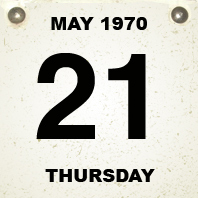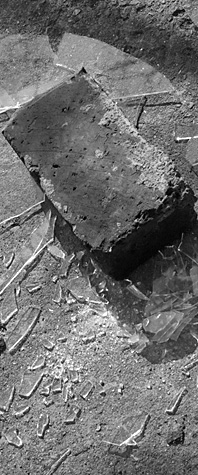MAY 7-18- THE UNIVERSITY CLOSED For the next nearly two weeks, the university was closed. No classes were held. Buildings were locked. Dorms were emptied and students sent back to wherever they came from. Even WOSU radio and TV were off the air. The administration used the break to formulate its responses to the protesters' demands. |
||
|
||
|
MAY 21- VIOLENCE FLARES AGAIN The university reopened on Tuesday, May 19th. Divisions were evident in the student body and in the ranks of protestors. The overwhelming majority of students just wanted to get back to class. Most protestors just wanted to say their piece without any more violence. Talks with the administration were beginning to bear fruit. Student concerns were being addressed. Some protesters continued to call for a strike but their support, even in their own ranks, was uncertain. A hardcore of radicals, however, were determined to see the campus burn again. The division among the protesters broke mostly along racial lines. An afternoon rally on May 21 showed the radicals without support on campus. Calls to strike and shut campus down again were met with boos from the crowd. A black militant leader accused those who disagreed with him of being racists. More boos. As they had done before, the radicals tried to barricade classrooms and the Main Library to prevent students from going to class. Students refused to be coerced. They did not support the strike and made their way around the blockades. Late in the afternoon a group of black militants tried to tear down the American flag from the flagpole in front of the Administration Building. Another group of students intervened to stop them. A violent contest broke out over the fallen flag. One of the students got the flag away from the militants and put it in the safe keeping of a guard at the building door. Militants took out their frustration by severely beating two of the students who stopped them. After briefly trying to close Neil at 11th, about 250 militants advanced to High and 11th and threw up a hasty barricade of trash cans and saw horses. They were joined by street kids and gang members. Rush hour traffic attempting to pass through was pelted with bricks and stones. Several reporters and cameramen covering the violence were attacked, beaten, and their cameras destroyed. The rioters began smashing windows of businesses and university buildings along High St. Rioters started looting some of the stores, stealing whatever they could grab. Students watched the mayhem but they did not join in. They did not support the rioters. Some even tried to intervene to stop the looters. Many students cheered as police arrived on the scene. Columbus police and Franklin County sheriff’s deputies quickly mobilized at High and 8th. Armed with tear gas grenades and shotguns firing knee-knocker bullets and backed up by a helicopter and water cannon, law enforcement was well-equipped to quell the riot. The rioters fled before the advancing police. They regrouped at 12th, smashing more windows, looting, and raining missiles on the advancing police. The police sent tear gas grenades into the mob and discharged rounds of wooden bullets. Some rioters had enough and fled High St., disappearing into the surrounding neighborhoods. The rest retreated further north up High Street where the scene was reenacted. By early evening, the riot was crushed. Most of the participants had fled or were arrested. |
|
Between 11th and Lane, only three buildings on High Street had escaped having their windows smashed. The Law School, the Ohio Union, and Mershon had suffered particularly heavy damage. Several businesses had been looted. Numerous bystanders had been assaulted. Mayor Sensenbrenner reimposed a district-wide curfew. The governor sent 5,000 National Guardsmen to campus to maintain order. The administration instituted a policy of I.D. checks to keep trouble-makers off campus. The curfew and Guard stayed until the end of the quarter. Closing the university again was discussed but the idea was abandoned. The rioters had enjoyed no significant student support. Looking through the arrestees, there were very few students. Instead, most of the May 21 rioters turned out to be local criminals and persons with no connection to Ohio State.
MAY 21- JUNE 12- THE PROTESTS DIE OUT Despite the events of May 21, some enthusiasm for continuing the protests remained on campus. The Ad Hoc Committee called for a resumption of student strikes, marches, sit-ins, teach-ins, and building blockades. In the last weeks of May, Oval rallies and marches drew thousands of participants. Polls showed 57% of students supporting the protest agenda. Meanwhile forces of reaction were moving. A group of conservative parents filed a $1 million lawsuit against protest organizers claiming they had interfered with their children's education. The parents also sought an injunction against any further protests on campus. At the same time, state legislators passed a bill to allow expulsion of students and firing of faculty and staff involved in campus disruptions. The law was sloppy, unconstitutional, and harsh but--like the ridiculous lawsuit--it had a chilling effect. On June 1, about 1,000 protesters marched from the Oval and besieged the Army ROTC building, tearing down fences and vandalizing cars in the parking lot. Unable to force their way in they turned to the Navy ROTC building where they had greater success and forced entry into building. The university siezed on these actions and ordered the arrests of most of the protest leadership. Further weakening the radical cause, the administration ultimately granted many of the protesters' demands. 1970 saw the creation of an Office of Minority Affairs, a Black Studies Department, a Women's Studies Department, daycare, student representation on the Board of Trustees and on the Ohio Board of Regents, and amnesty for many involved in the troubles. Opinion on the war began to move. A June 27, 1970 Gallup poll found 56% of Americans agreeing that it was "a mistake to send troops to Vietnam." Racism and sexism persisted, cops didn't stop acting like thugs, and the war dragged on for three more bloody and pointless years but protesers had some achievements to point to. By the end of the quarter interest in the protests was swiftly falling away, a rally for the arrested students on June 10 struggled to draw 200 people. On June 12, the quarter ended a students took their exams and headed to their far-flung homes. |
||
|


